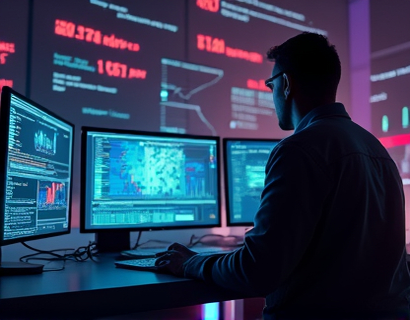Maximize Your Multi-Channel Announcements: A Strategic Guide for Businesses and Individuals
In today's fast-paced digital landscape, effective communication is crucial for businesses and individuals aiming to stand out and connect with their audience. Multi-channel announcements offer a powerful way to reach a broader audience, but managing these announcements across various platforms can be challenging. This comprehensive guide provides expert strategies to streamline your publishing process and enhance message visibility, ensuring maximum reach and engagement. By adopting a user-friendly approach, this guide is tailored for businesses and individuals seeking robust multi-channel solutions to optimize their communication strategy.
Understanding Multi-Channel Communication
Multi-channel communication involves using multiple platforms to disseminate information to your audience. This can include social media, email newsletters, websites, blogs, and more. Each channel has its unique audience and engagement dynamics, making it essential to tailor your messages accordingly. The key to successful multi-channel communication lies in consistency, clarity, and relevance across all platforms. By ensuring your message is cohesive and aligned with your brand's voice, you can build trust and credibility with your audience.
Benefits of Multi-Channel Announcements
Engaging your audience through multiple channels offers several advantages. Firstly, it increases the likelihood of reaching a wider audience, as different people consume information through different platforms. For instance, while some may prefer social media for real-time updates, others might rely on email for detailed information. By using multiple channels, you can cater to these diverse preferences, ensuring no segment of your audience is left behind.
Secondly, multi-channel announcements enhance message visibility and retention. Repeating your message across various platforms reinforces its importance and helps it stick in the minds of your audience. This repetition can lead to higher engagement rates, whether through likes, shares, comments, or direct responses. Additionally, multi-channel communication allows for better crisis management, as you can quickly address issues across multiple platforms, providing timely and consistent updates.
Challenges of Multi-Channel Announcements
While the benefits are clear, managing multi-channel announcements comes with its own set of challenges. One of the primary issues is the complexity of coordinating messages across different platforms. Each platform has its own set of rules, audience behaviors, and content preferences. For example, a tweet that works well on Twitter may not translate effectively to a LinkedIn post. This requires a deep understanding of each platform and the ability to adapt your content accordingly.
Another challenge is maintaining consistency in branding and messaging. With multiple channels, there's a risk of sending mixed signals to your audience if your messages are not aligned. This can dilute your brand's identity and confuse your audience. To avoid this, it's essential to have a clear brand strategy and communication plan that outlines how your message will be presented across all channels.
Strategies for Effective Multi-Channel Announcements
To overcome the challenges and maximize the impact of your multi-channel announcements, consider the following strategies:
1. Develop a Centralized Content Calendar
A centralized content calendar is a powerful tool for managing multi-channel announcements. It helps you plan, schedule, and track your content across all platforms in one place. Start by identifying the key channels where your audience is most active and create a calendar that outlines the type of content, the date of publication, and the specific platform. This ensures a coordinated approach and reduces the risk of overlapping or conflicting messages.
Use digital tools like Google Calendar, Trello, or Asana to create and manage your content calendar. These tools allow you to set reminders, assign tasks, and collaborate with team members, making the process more efficient and organized.
2. Tailor Content for Each Platform
While having a centralized calendar is essential, it's equally important to tailor your content to suit each platform's unique characteristics. For instance, Twitter's character limit requires concise and impactful messages, whereas LinkedIn allows for more detailed and professional content. Here are some platform-specific tips:
- Twitter: Use hashtags, mention relevant users, and include visuals to increase engagement.
- Facebook: Post longer updates, use high-quality images, and encourage interactions through questions or polls.
- Email Newsletters: Provide in-depth information, include calls to action, and segment your audience for personalized content.
- Blogs: Create comprehensive articles with valuable insights, optimize for SEO, and promote them across other channels.
By understanding the strengths and limitations of each platform, you can create content that resonates with your audience and drives the desired actions.
3. Utilize Automation Tools
Managing multi-channel announcements manually can be time-consuming and prone to errors. Automation tools can significantly streamline the process, saving you time and reducing the risk of mistakes. Tools like Hootsuite, Buffer, and Sprout Social allow you to schedule posts across multiple platforms from a single interface. These tools also offer analytics and insights, helping you track the performance of your announcements and make data-driven decisions.
When selecting automation tools, consider factors such as ease of use, integration capabilities, and customer support. Ensure the tool aligns with your specific needs and budget, and test it thoroughly before fully implementing it into your workflow.
4. Monitor and Engage with Your Audience
Multi-channel announcements are not just about broadcasting messages; they are also about engaging with your audience. Monitoring comments, messages, and mentions across all platforms allows you to respond promptly to queries, address concerns, and build relationships with your audience. This engagement can lead to higher loyalty and advocacy for your brand.
Use social listening tools to track conversations related to your brand and industry. Tools like Brandwatch and Mention can help you identify trends, sentiment, and key influencers, providing valuable insights to inform your communication strategy.
5. Measure and Optimize
To ensure your multi-channel announcements are effective, it's crucial to measure their performance regularly. Set clear goals and key performance indicators (KPIs) such as engagement rates, click-through rates, and conversion rates. Use analytics tools provided by each platform or third-party solutions like Google Analytics to track these metrics.
Analyze the data to identify what works and what doesn't. For example, if a particular type of content performs better on one platform, consider creating more of that content. Adjust your strategy based on these insights to continuously improve your multi-channel communication.
Best Practices for Multi-Channel Announcements
In addition to the strategies mentioned, here are some best practices to enhance your multi-channel announcements:
1. Know Your Audience
Understanding your audience is the foundation of effective communication. Conduct research to gather insights into their demographics, preferences, and behaviors. This knowledge will help you create targeted and relevant content that resonates with them. Use surveys, feedback forms, and social media insights to gain a deeper understanding of your audience.
2. Maintain Consistency
Consistency in branding, messaging, and posting frequency is crucial for building a strong brand identity. Ensure that your logo, color scheme, and tone of voice are consistent across all channels. This helps in creating a recognizable and trustworthy brand presence.
Additionally, maintain a regular posting schedule to keep your audience engaged. Whether it's daily, weekly, or monthly, stick to your schedule to build anticipation and expectation.
3. Use Visuals and Multimedia
Visual content such as images, videos, and infographics can significantly enhance the appeal and shareability of your announcements. Visuals help break up text, making your content more digestible and engaging. Use high-quality visuals that align with your message and brand aesthetic.
Consider creating short videos or animated GIFs to capture attention and convey complex information in a simple, memorable way. Platforms like YouTube, Instagram, and TikTok are particularly effective for video content.
4. Encourage User-Generated Content
User-generated content (UGC) can add authenticity and variety to your multi-channel announcements. Encourage your audience to share their experiences, photos, or testimonials related to your brand. This not only provides social proof but also fosters a sense of community and involvement.
Create dedicated hashtags for UGC campaigns and feature the best submissions on your official channels. This can incentivize more users to participate and share their content, expanding your reach organically.
5. Test and Experiment
Don't be afraid to try new approaches and experiment with different content types, formats, and timing. Testing allows you to discover what works best for your audience and refine your strategy over time. Use A/B testing to compare the performance of different versions of your content and identify the most effective elements.
Stay updated with the latest trends and platform updates to stay ahead of the curve. Adaptability is key in the ever-evolving digital landscape.
Conclusion
Maximizing your multi-channel announcements requires a strategic and thoughtful approach. By understanding the benefits and challenges, developing a centralized content calendar, tailoring content for each platform, utilizing automation tools, monitoring audience engagement, and following best practices, you can enhance your communication strategy and connect more effectively with your audience.
Remember, the goal is not just to broadcast messages but to build meaningful relationships and create value for your audience. With the right strategies and tools, you can achieve maximum reach and engagement across multiple channels, setting your brand apart in a competitive market.










































